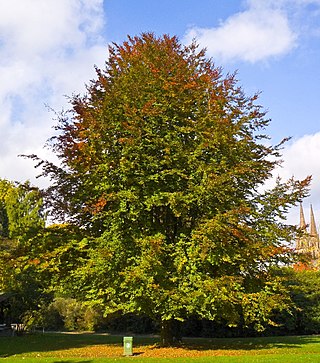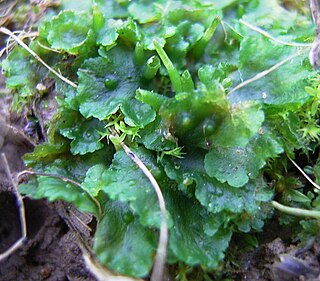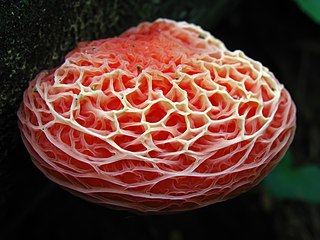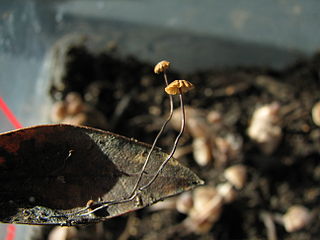Related Research Articles

The Fagaceae are a family of flowering plants that includes beeches, chestnuts and oaks, and comprises eight genera with about 927 species. Fagaceae in temperate regions are mostly deciduous, whereas in the tropics, many species occur as evergreen trees and shrubs. They are characterized by alternate simple leaves with pinnate venation, unisexual flowers in the form of catkins, and fruit in the form of cup-like (cupule) nuts. Their leaves are often lobed, and both petioles and stipules are generally present. Their fruits lack endosperm and lie in a scaly or spiny husk that may or may not enclose the entire nut, which may consist of one to seven seeds. In the oaks, genus Quercus, the fruit is a non-valved nut called an acorn. The husk of the acorn in most oaks only forms a cup in which the nut sits. Other members of the family have fully enclosed nuts. Fagaceae is one of the most ecologically important woody plant families in the Northern Hemisphere, as oaks form the backbone of temperate forest in North America, Europe, and Asia, and are one of the most significant sources of wildlife food.

The Notothyladaceae is the only family of hornworts in the order Notothyladales.

Suillus is a genus of basidiomycete fungi in the family Suillaceae and order Boletales. Species in the genus are associated with trees in the pine family (Pinaceae), and are mostly distributed in temperate locations in the Northern Hemisphere, although some species have been introduced to the Southern Hemisphere.

Rhodocybe is a genus of fungi in the family Entolomataceae. Basidiocarps are agaricoid producing pink basidiospores that are unevenly roughened or pustular under the microscope. Species are saprotrophic and mostly grow on the ground, occasionally on wood. The genus is distributed worldwide.

Calostoma is a genus of 29 species of gasteroid fungi in the suborder Sclerodermatineae. Like other gasteroid fungi, Calostoma do not have the spore discharge mechanism associated with typical gilled fungi (ballistospory), and instead have enclosed spore-bearing structures. Resembling round puffballs with raised, brightly colored spore openings (ostioles), elevated on a thick, gelatinous stalks, species have been collected in regions of deciduous, temperate, tropical or subtropical forests. Their distribution includes eastern North America, Central America, Asia, and Australasia. The common name given to some species, "prettymouth", alludes to the brightly colored raised openings (ostioles) that may somewhat resemble lips. Other common names include "hotlips" and "puffball in aspic".

The Physalacriaceae are a family of fungi in the order Agaricales. Species in the family have a widespread distribution, ranging from the Arctic, (Rhizomarasmius), to the tropics, e.g. Gloiocephala, and from marine sites (Mycaureola) and fresh waters (Gloiocephala) to semiarid forests (Xerula).

Auricularia is a genus of fungi in the family Auriculariaceae. Basidiocarps are typically gelatinous and ear-shaped, with a slightly downy to conspicuously hirsute upper surface and an under surface that is smooth, wrinkled or veined. All species grow on wood. Several Auricularia species are edible and commercially cultivated on a large scale in China and East Asia.

Cyptotrama asprata, commonly known as the golden-scruffy collybia or spiny woodknight is a saprobic species of mushroom in the family Physalacriaceae. Widely distributed in tropical regions of the world, it is characterized by the bright orange to yellow cap that in young specimens is covered with tufts of fibrils resembling small spikes. This fungus has had a varied taxonomical history, having been placed in fourteen genera before finally settling in Cyptotrama. This species is differentiated from several other similar members of genus Cyptotrama by variations in cap color, and spore size and shape.

Oudemansiella australis is a species of gilled mushroom in the family Physalacriaceae. It is found in Australasia, where it grows on rotting wood. It produces fruit bodies that are white, with caps up to 5.5 cm (2.2 in) in diameter, attached to short, thick stems.

Cyptotrama is a genus of mushrooms in the family Physalacriaceae.

Fissurina is a genus of lichenized fungi in the family Graphidaceae. It has about 160 species, most of which are found in tropical regions.

Rhodotus is a genus in the fungus family Physalacriaceae. There are two species in the genus with the best known, Rhodotus palmatus, called the netted rhodotus, the rosy veincap, or the wrinkled peach. This uncommon species has a circumboreal distribution, and has been collected in eastern North America, northern Africa, Europe, and Asia; declining populations in Europe have led to its appearance in over half of the European fungal Red Lists of threatened species. Typically found growing on the stumps and logs of rotting hardwoods, mature specimens may usually be identified by the pinkish color and the distinctive ridged and veined surface of their rubbery caps; variations in the color and quantity of light received during development lead to variations in the size, shape, and cap color of fruit bodies.

Skeletocutis is a genus of about 40 species of poroid fungi in the family Polyporaceae. The genus has a cosmopolitan distribution, although most species are found in the Northern Hemisphere. It causes a white rot in a diverse array of woody substrates, and the fruit bodies grow as a crust on the surface of the decaying wood. Sometimes the edges of the crust are turned outward to form rudimentary bracket-like caps.

Lycoperdon echinatum, commonly known as the spiny puffball or the spring puffball, is a type of puffball mushroom in the family Agaricaceae. The saprobic species has been found in Africa, Europe, Central America, and North America, where it grows on soil in deciduous woods, glades, and pastures. It has been proposed that North American specimens be considered a separate species, Lycoperdon americanum, but this suggestion has not been followed by most authors. Molecular analysis indicates that L. echinatum is closely related to the puffball genus Handkea.
Naiadolina is an agaric fungal genus that produces striking, yellowish fruit bodies on sedges in wetlands in eastern Canada. The lamellae are merulioid, forked and anastomosing. The type species was previously classified as a Marasmius in the Marasmiaceae, but phylogenetically, Naiadolina flavomerulina is in the Physalacriaceae sister to the genus Cryptomarasmius.

Cryptomarasmius is a genus of fungi in the family Physalacriaceae.

Butyriboletus is a genus of fungi in the family Boletaceae. The genus was circumscribed in 2014 by mycologists David Arora and Jonathan L. Frank to accommodate "butter bolete" species that were shown by molecular analysis to be phylogenetically distinct from Boletus. Butyriboletus contains 24 ectomycorrhizal species found in Asia, Europe, North America and north Africa.

Clavulinopsis laeticolor is a clavarioid fungus in the family Clavariaceae. In the UK, it has the recommended English name of handsome club. It forms slender, cylindrical, yellow fruit bodies that grow on the ground in woodland litter or in agriculturally unimproved grassland. It was originally described from Cuba and is part of a species complex as yet unresolved.
Truncospora is a genus of 10 species of fungi in the family Polyporaceae.
Postia duplicata is a species of poroid fungus in the family Fomitopsidaceae that was described as a new species in 2014. It is found in Yunnan and Zhejiang provinces of China, where it causes a brown rot on angiosperm wood. The fungus is named (duplicata) for its characteristic two-layered context, a feature that distinguishes it from other Postia species. The spores made by this fungus are cylindrical, hyaline, smooth, and typically measure 3.8–5.8 by 1.8–2.5 µm.
References
- 1 2 Hao YJ, Qin J, Yang ZL (2014). "Cibaomyces, a new genus of Physalacriaceae from East Asia" (PDF). Phytotaxa. 162 (4): 198–210. doi:10.11646/phytotaxa.162.4.2.
- ↑ Moreau, P-A.; Vila, J.; Aime, M.C.; Antonín, V.; Horak, E.; Pérez-Butrón, J.L.; Richard, F.; Urban, A.; Welti, S.; Vizzini, A. (2015). "Cibaomyces and Cyptotrama, two new genera for Europe, and an emendation of Rhizomarasmius (Basidiomycota, Physalacriaceae)". Mycol. Progress. 14 (2). doi:10.1007/s11557-015-1024-4. hdl: 2318/153555 . S2CID 255315637.
- ↑ "MycoBank 中文版". 2014-10-28. Archived from the original on 2014-10-28.